Originally published on January 25, 2024
For decades climate catastrophists have portrayed climate disasters as getting deadlier and deadlier.
Now that I and others have documented that we're safer than ever from climate, catastrophists are saying that disaster deaths don't matter!
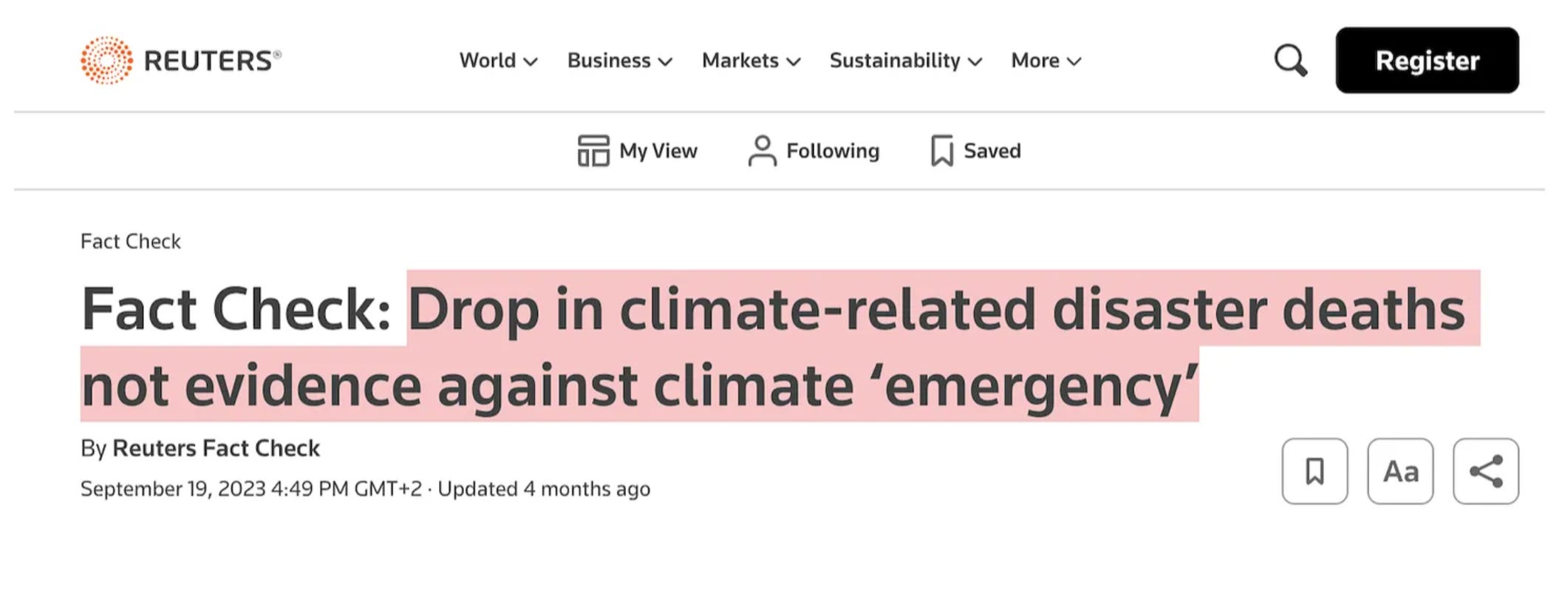
-
Reuters says “Drop in climate-related disaster deaths not evidence against climate emergency.”
But a drop in deaths from something—here, a 98% drop—is obvious evidence against it being an emergency.
Would Reuters say: “98% drop in flu deaths not evidence against flu emergency”?1
-
Why is Reuters, along with The New York Times, PolitiFact, and USA Today, claiming that a 98% drop in climate disaster deaths doesn't contradict their climate emergency narrative? Because it obviously does, and they can only save their narrative by intimidating us into denying the obvious.2
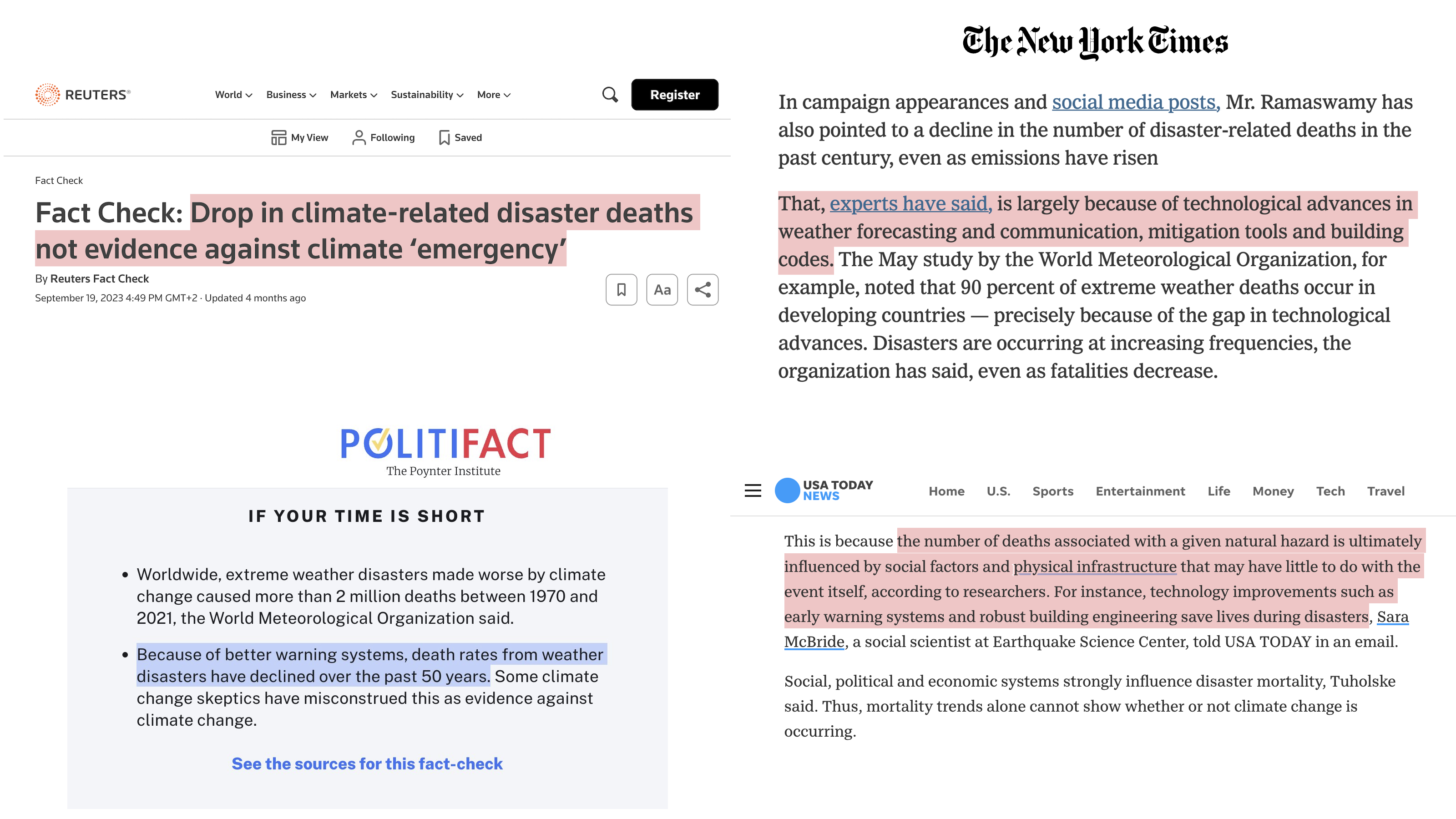
-
The central narrative of climate catastrophists is that fossil fuels and their CO2 emissions are killing more and more people via climate disasters.
This narrative has always had a fatal weakness: it totally contradicts the data, which show plummeting climate disaster deaths.3
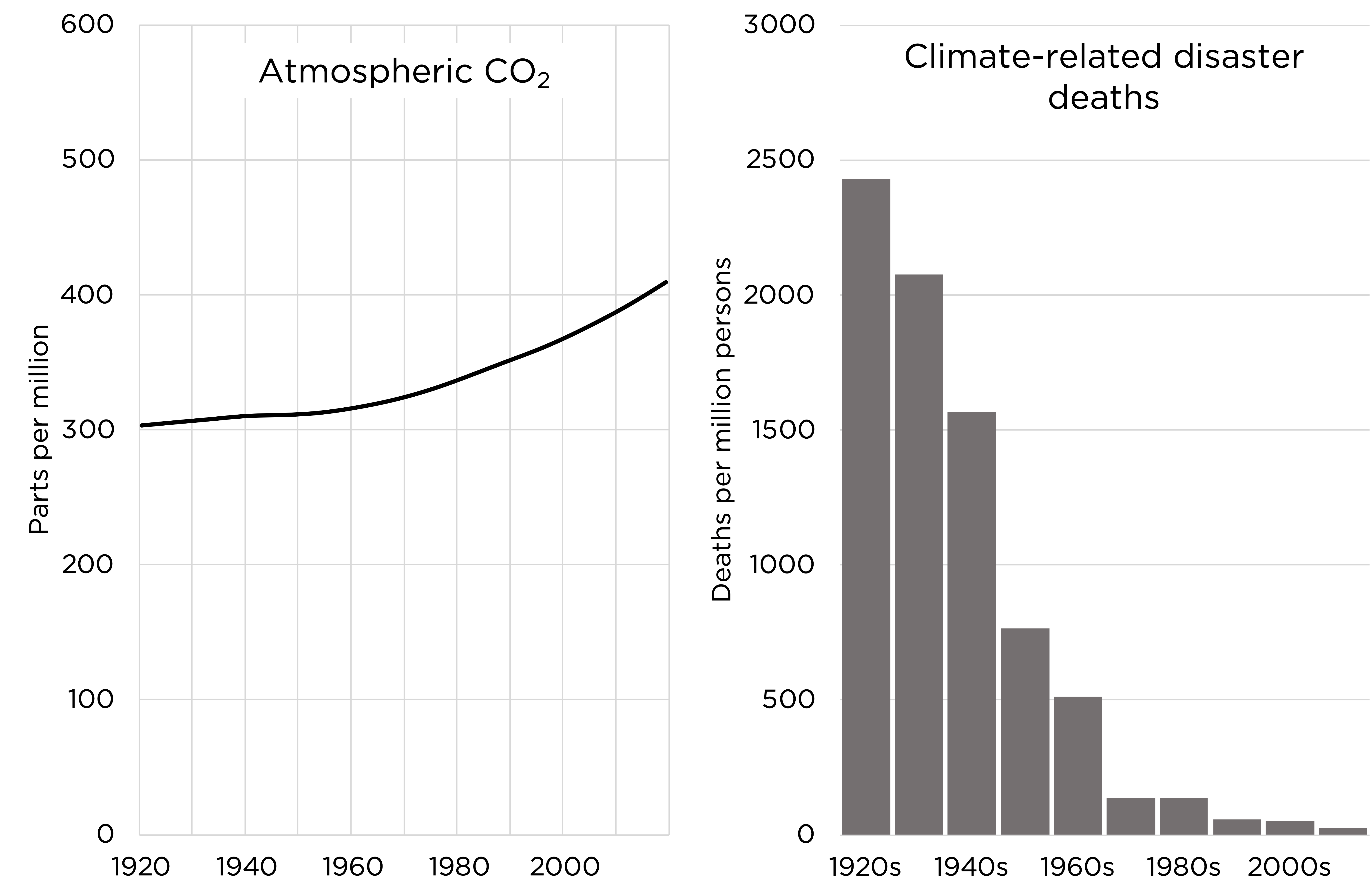
-
Why are climate disaster deaths plummeting as fossil fuel use and CO2 emissions rise?
Because the enormous ability uniquely cost-effective and scalable fossil fuel energy gives us to master climate danger far outweighs any new climate challenges from CO2 emissions.
-
An example of fossil-fueled climate mastery overwhelming CO2 impacts is drought.
Any contribution of rising CO2 to drought has been overwhelmed by fossil-fueled irrigation and crop transport, which have helped reduce drought deaths by over 100 times over 100 years as CO2 levels have risen.4
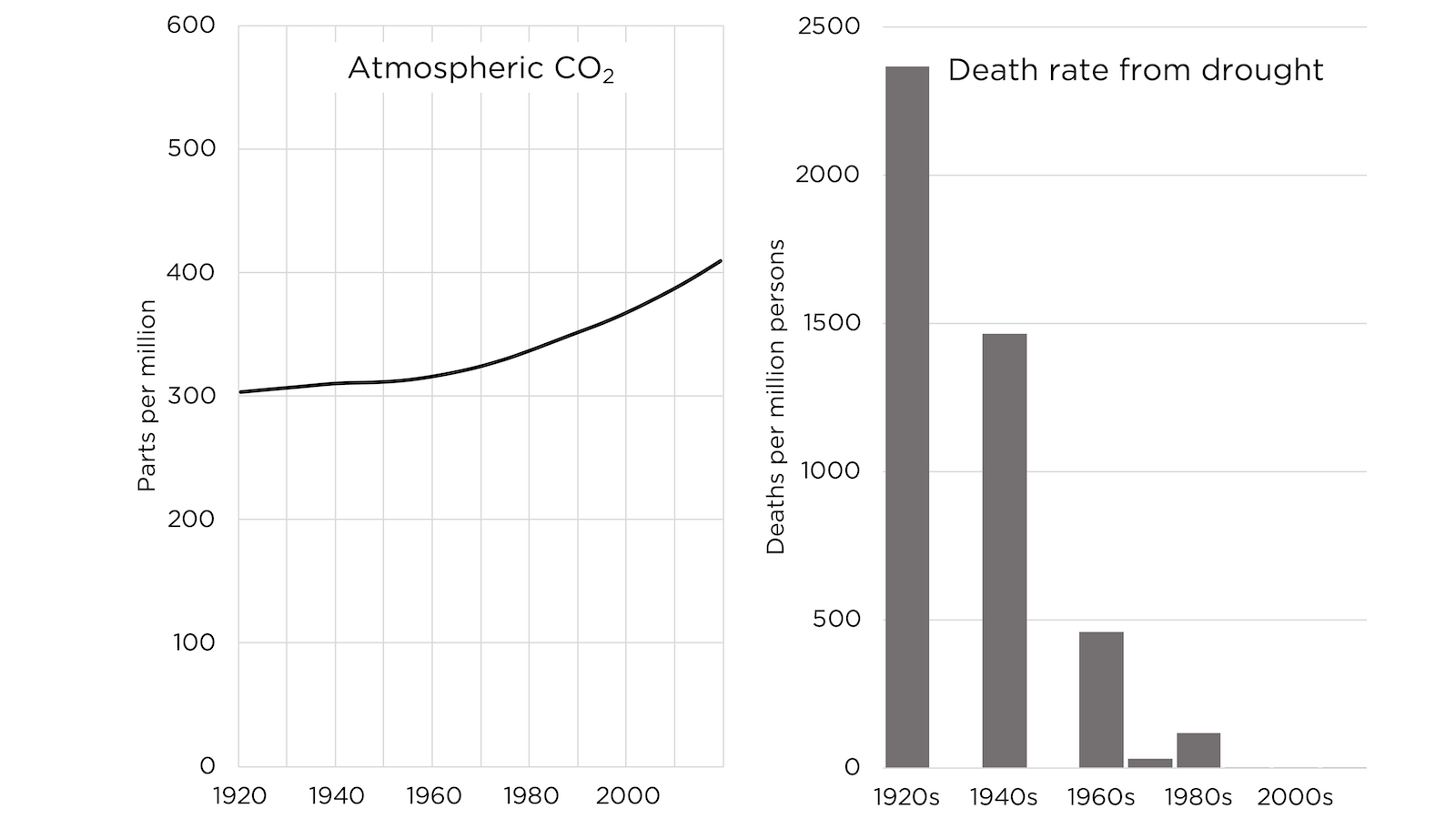
-
Over the last decade, I and a number of others, including Bjorn Lomborg and Michael Shellenberger, have challenged catastrophism by pointing to declining climate disaster deaths.
Catastrophists couldn't refute our argument. So instead they pretended it didn't exist.
Until last year.5
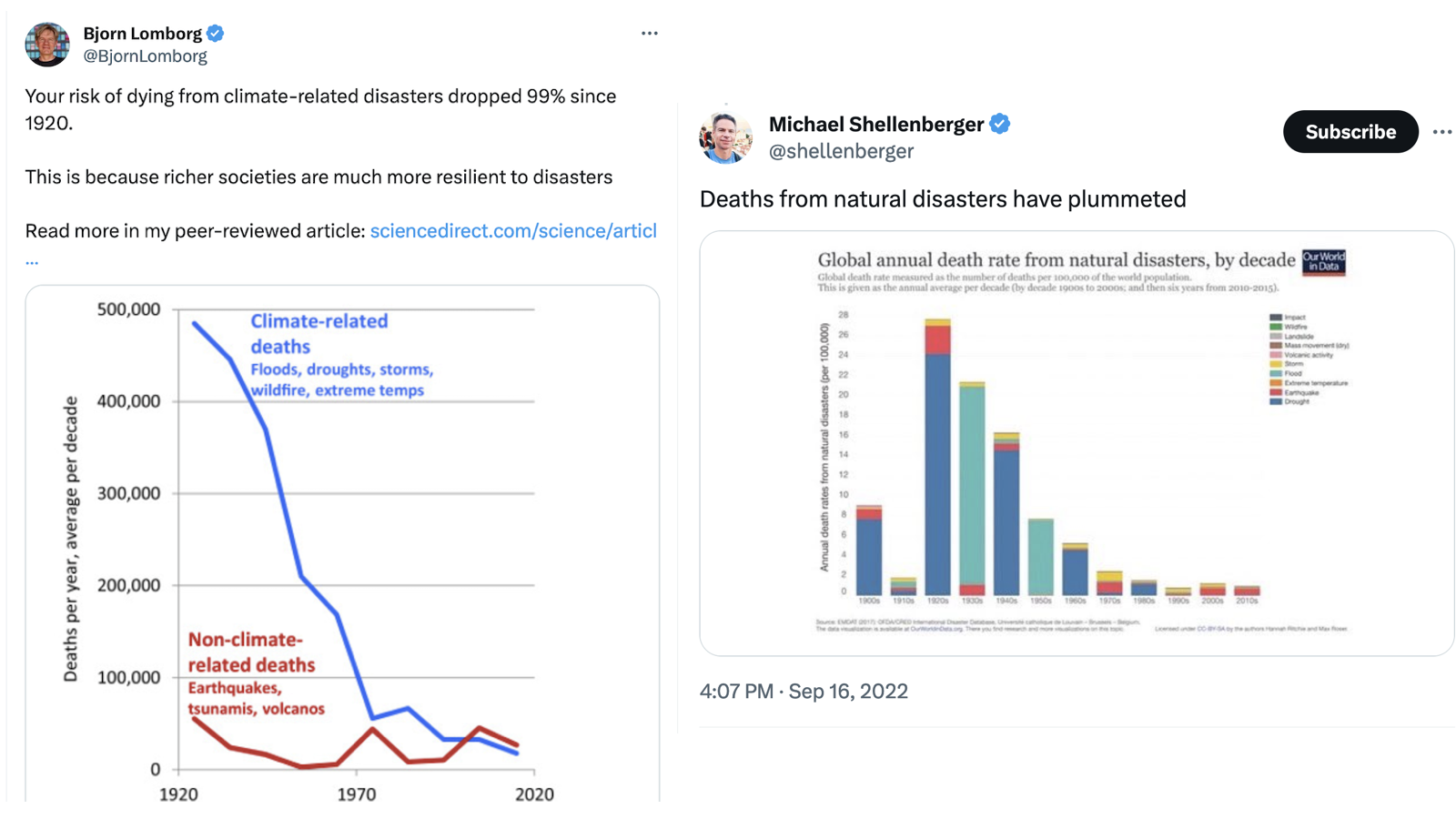
-
In 2023, climate catastrophists finally felt compelled to address the fact that climate disaster deaths have plummeted (driven by fossil-fueled climate mastery).
Because of honesty? No—because Presidential candidates started bringing it up and persuading people with it.
-
Here is Vivek Ramaswamy during his Presidential campaign referring to a 98% decline in climate disaster deaths—and, crucially, giving fossil fuel energy credit.
Vivek Ramaswamy on climate disaster deaths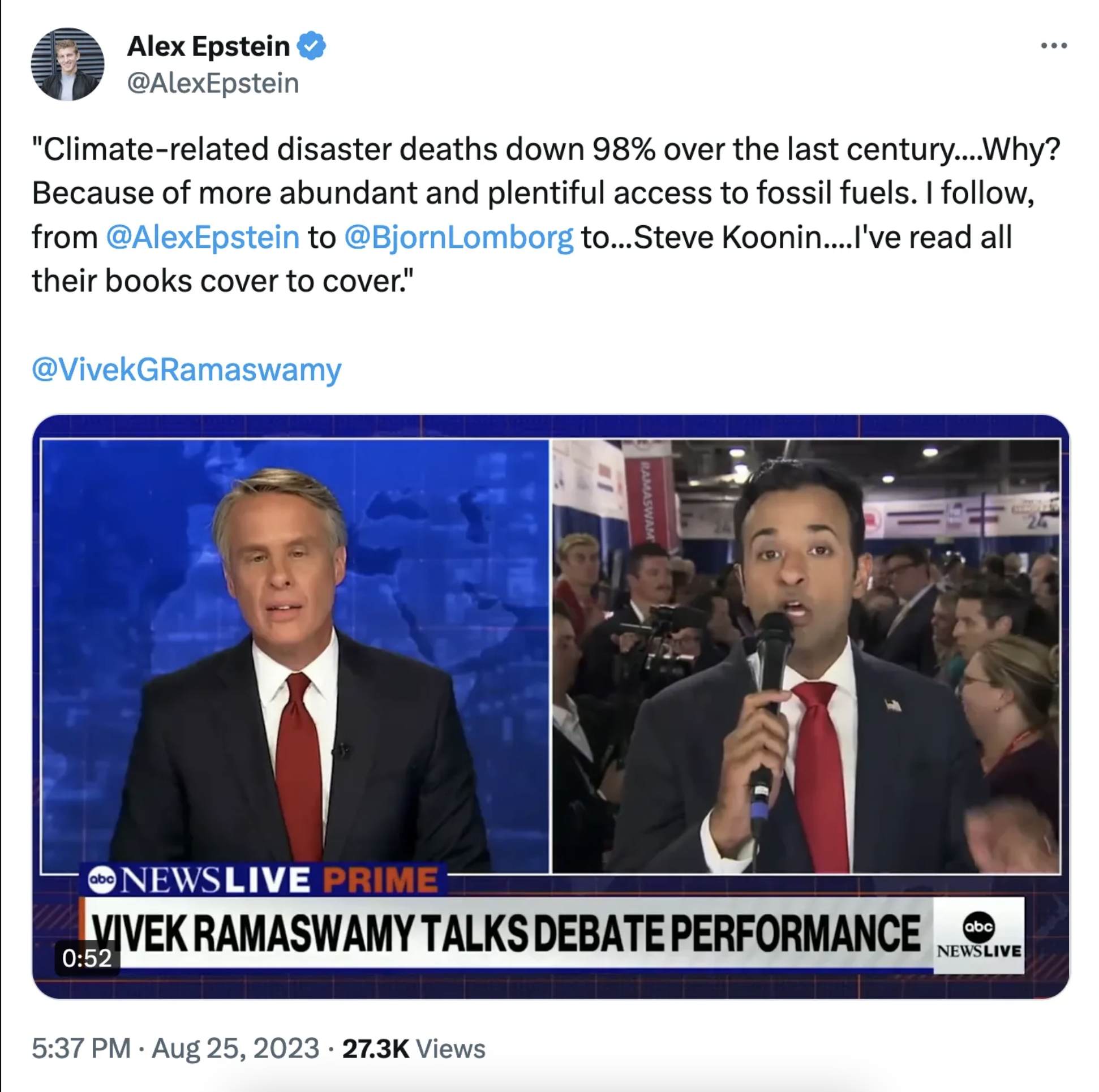
-
Here is Ron DeSantis during his Presidential campaign referring to a 98% decline in climate disaster deaths—and, crucially, giving fossil fuel energy credit.
Ron DeSanstis on climate disaster deaths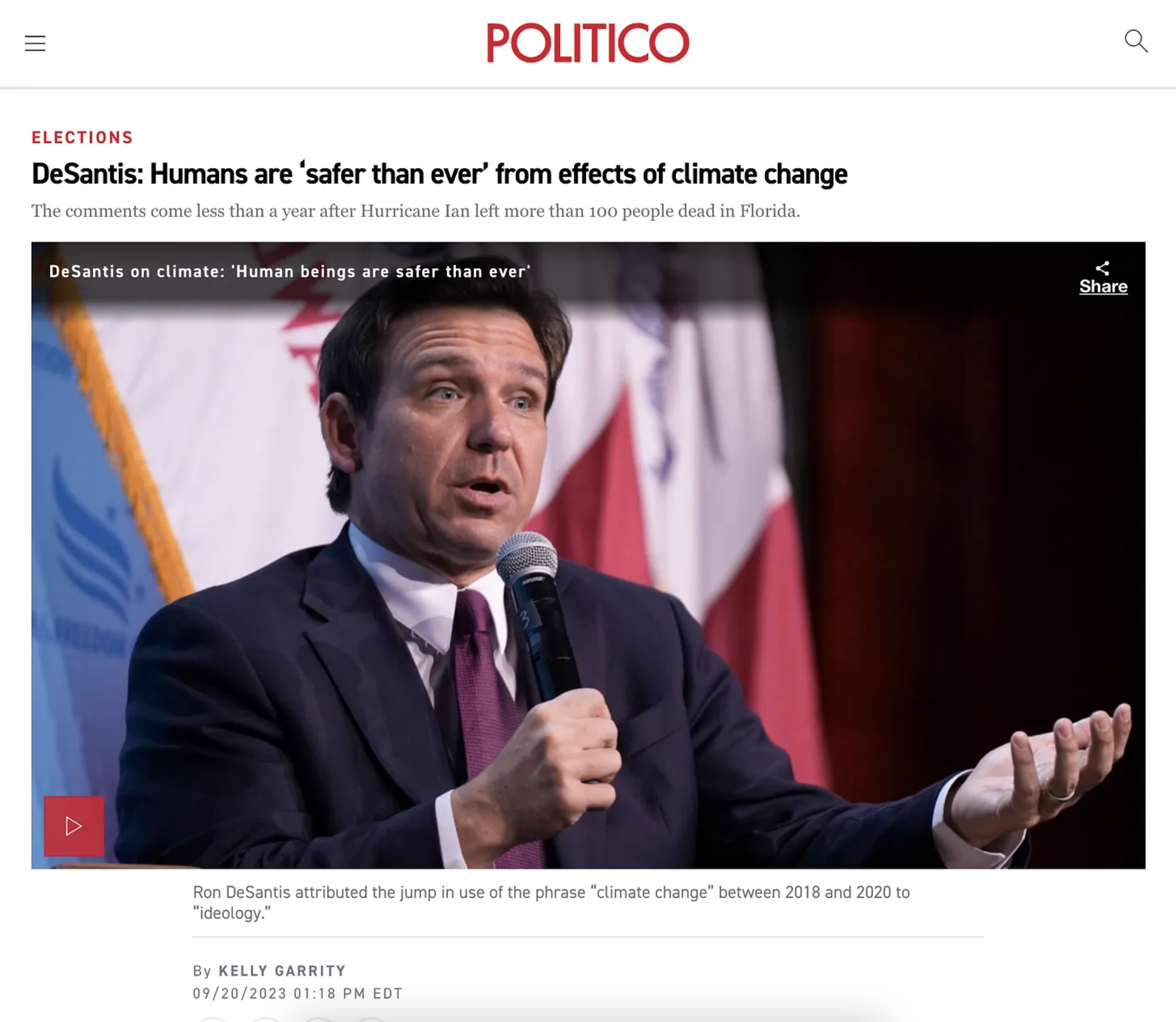
-
The 98% decline in climate disaster deaths, driven by fossil fuels, is a blockbuster fact: it shows that we are experiencing not fossil-fueled climate emergency but fossil-fueled climate safety.
But instead of being happy, catastrophists engage in climate safety denial.
-
Here are 3 recent instances of climate safety denial—from Reuters, PolitiFact, and USA Today. All have long portrayed climate deaths as a fast-increasing problem. But now they claim deaths don't matter.
-
Climate safety denial utilizes 5 main myths to evade the decline in disaster deaths:
- Fossil fuels don't deserve credit
- Weather forecasting deserves the credit
- 100 years is a misleading period
- Damages are drastically increasing
- There's a major increase in reported disasters
-
Myth 1: Fossil fuels don't deserve much credit for plummeting climate disaster deaths; it's “resilience.”
Truth: Uniquely cost-effective and scalable fossil fuel energy makes us resilient through plentiful infrastructure-building, heating and cooling, irrigation, transportation, etc.6

-
Myth 2: Storm warning systems deserve the credit for plummeting climate disaster deaths.
Truth: Drought, not storm, deaths are the leading source of reduced climate deaths. And fossil fuels power storm warning and evacuation systems (and more resilient infrastructure).7
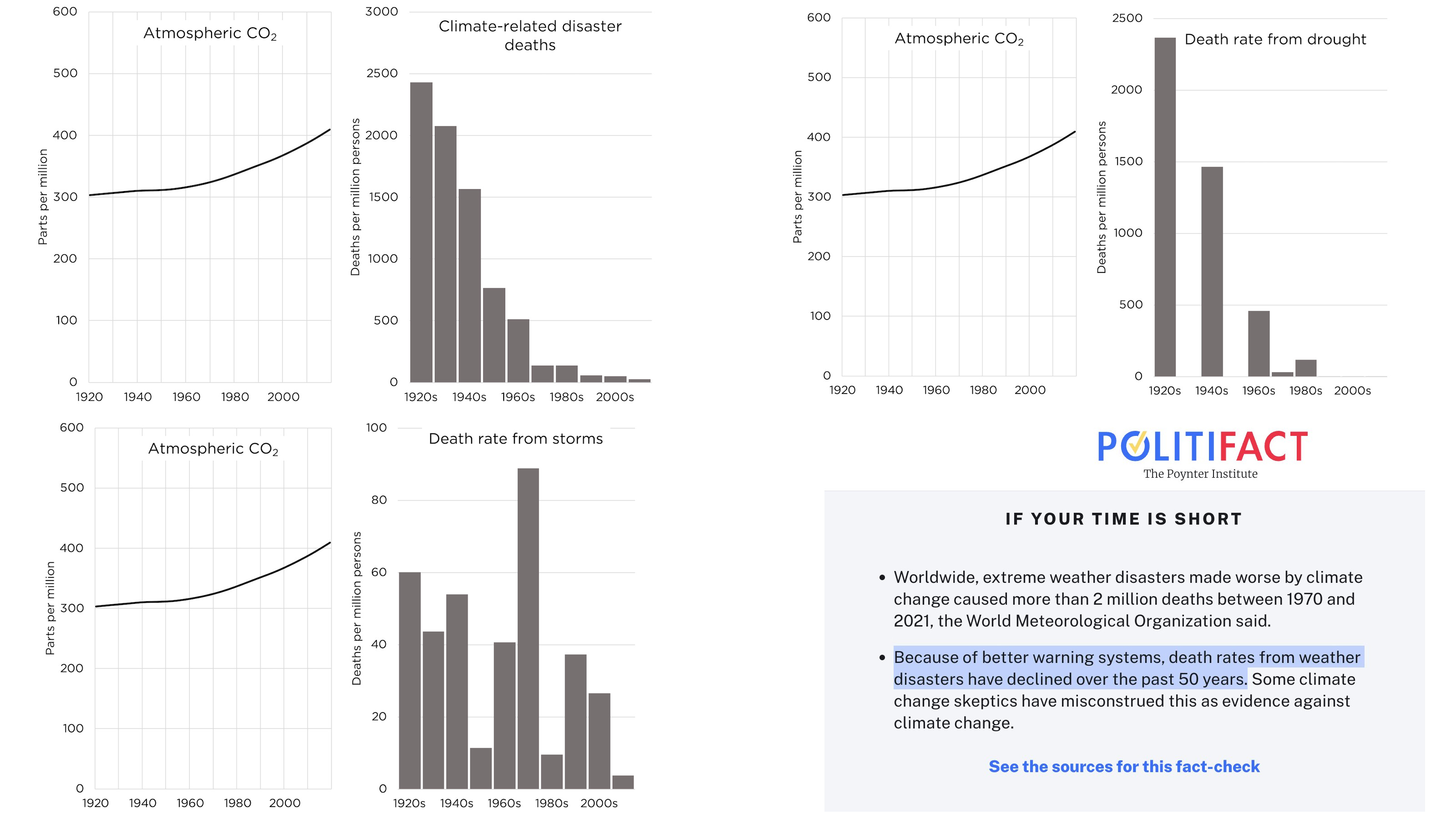
-
Myth 3: 100 years is a misleading period to measure plummeting climate disaster deaths.
Truth: 100 years is a standard, very meaningful period to look at. While we have data going back an additional two decades, those tend to underreport due to less global communication.8

-
Contrary to the claim that starting analysis of climate disaster deaths in the 1920s overestimates the decline, it actually likely underestimates the decline due to insufficient past reporting; data before WWII extremely likely underreport deaths compared to data after 2000.
-
Myth 4: There is an alarming increase in reported disasters, revealing an underlying climate emergency.
Truth: The increase in reported disasters over time is due overwhelmingly to increased global communication. Changes in fundamentals, such as storms, are extremely modest.9
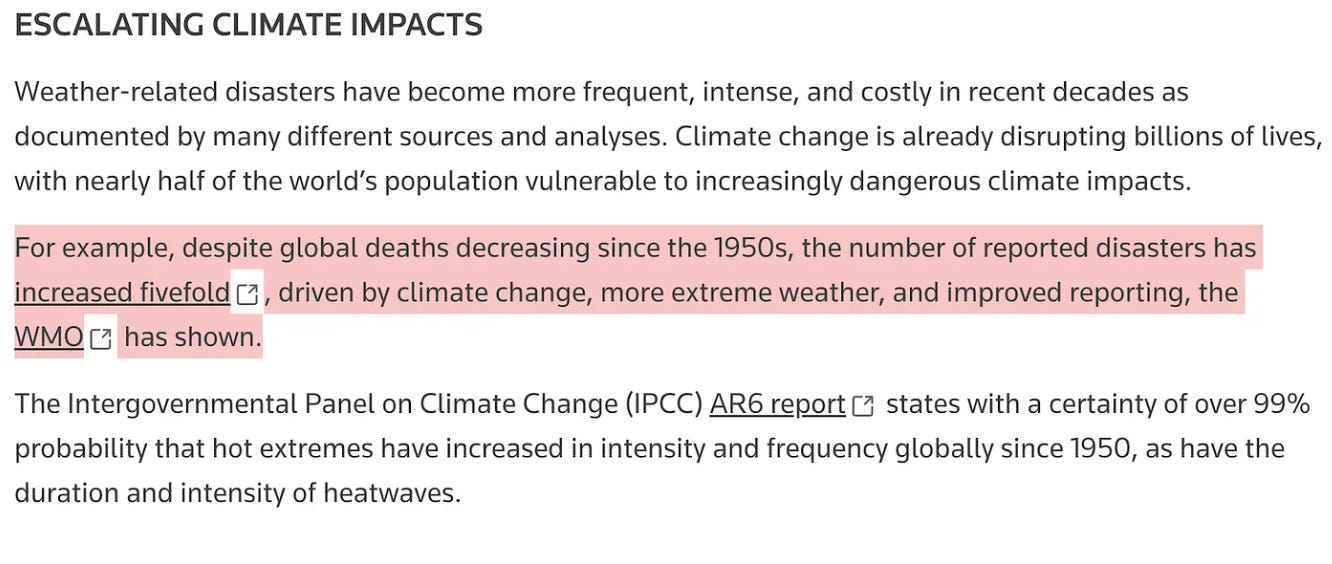
-
The claim that more reported disasters show an increasingly dangerous climate is absurd in light of the fact that underlying data show massive increases in reporting before significant human climate impacts and the reporting trend also massively goes up for non-climate causes!10
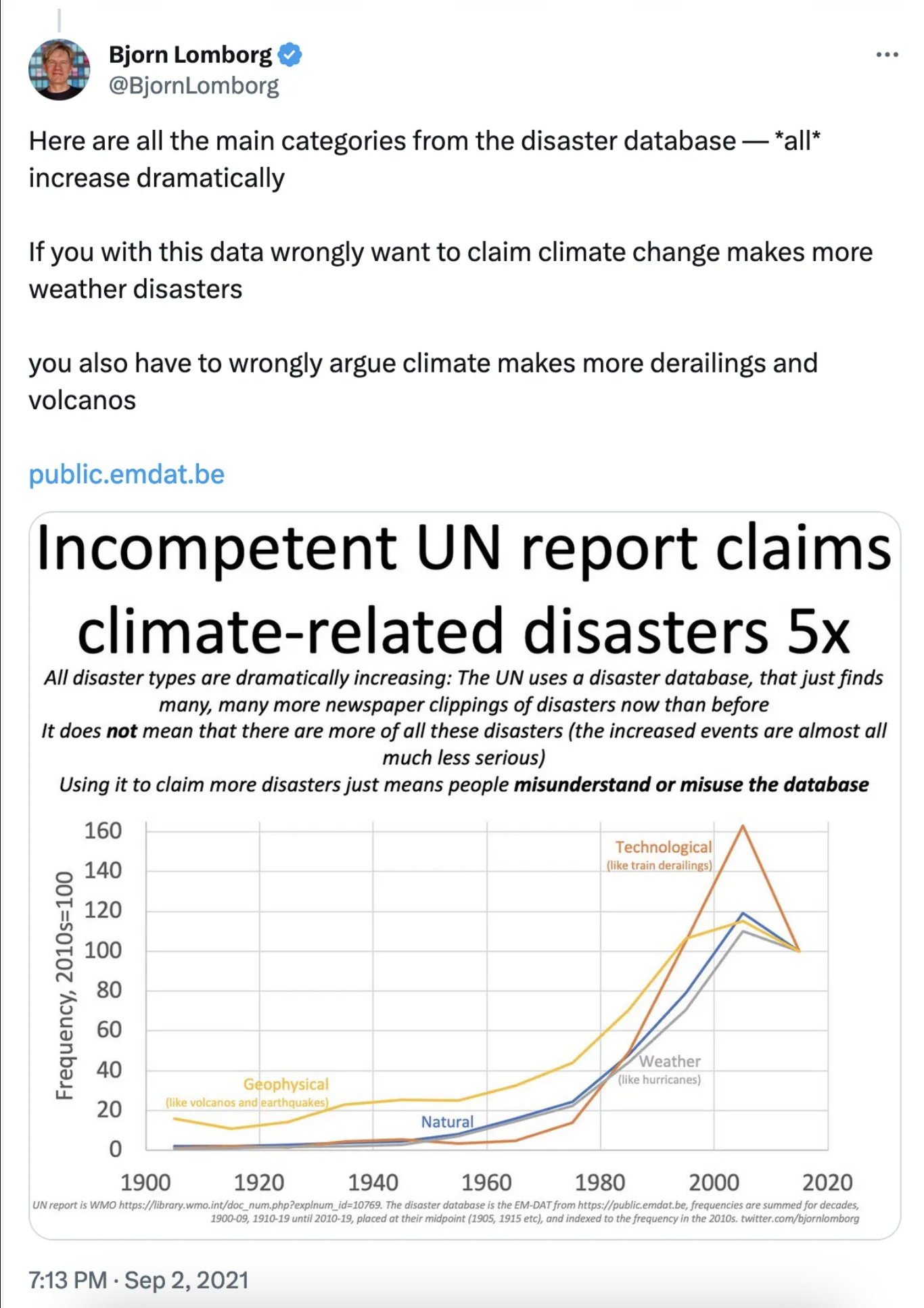
-
Other biases might inflate the number of reported disasters. E.g., governments of poor countries have an incentive to declare more disasters with increasing international relief.11
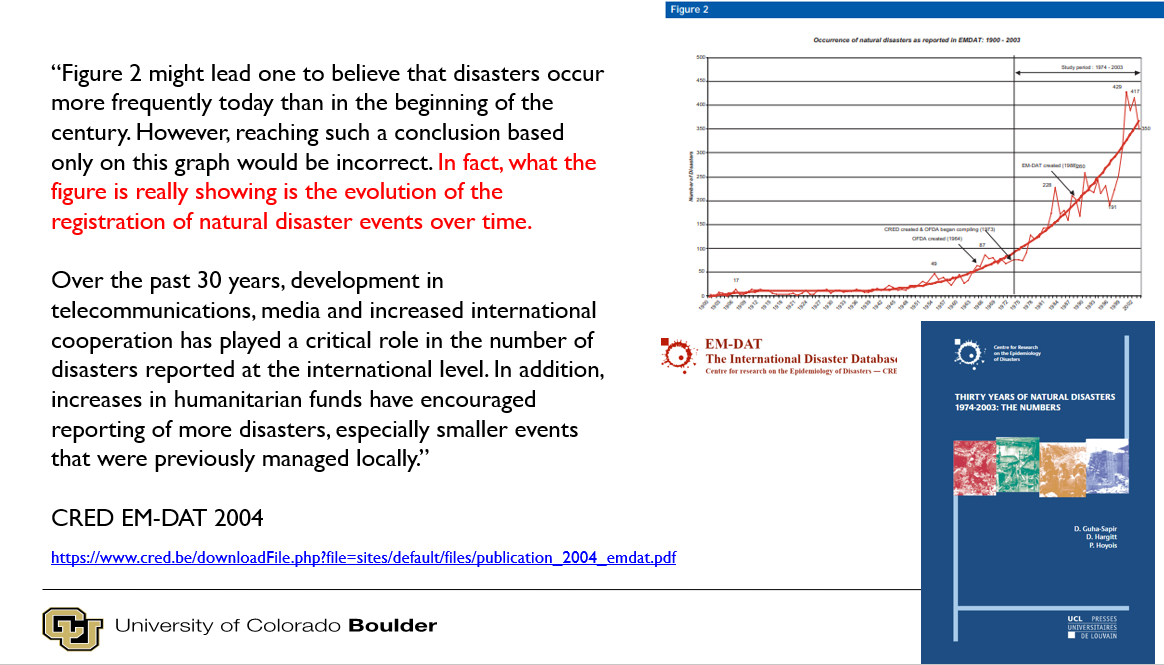
-
Using obviously problematic disaster frequency reporting instead of direct climatological evidence to try and show increasing climate danger is a revealing choice by catastrophists. They are making it because the climate change we've experienced has been very modest—and masterable.
Do Not Declare a “Climate Emergency” -
An example of unalarming climate fundamentals: neither the frequency nor the energy in global hurricanes has changed significantly relative to the noisy average. There is also little evidence for more landfalling hurricanes.12

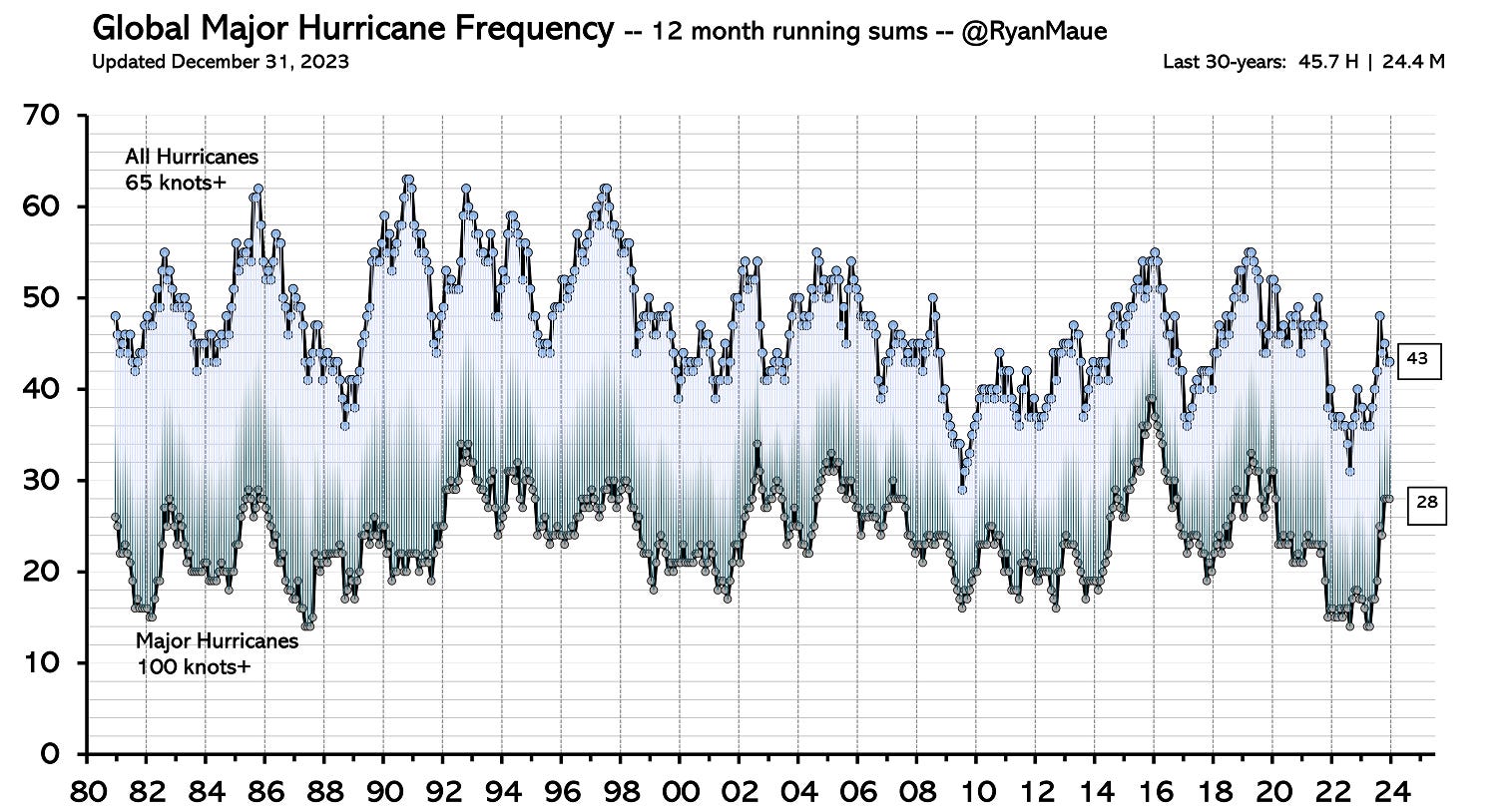

-
The catastrophist attempt to undermine the 98% decrease in disaster deaths by pointing to the increased reporting of disasters is actually self-defeating.
If disaster deaths are plummeting despite incomplete past reporting, that means they've declined by even more than 98%.
-
Myth 5: Climate damages are drastically increasing, revealing an underlying climate emergency.
Truth: Even though there are many incentives for climate damages to go up—preferences for riskier areas, government bailouts—GDP-adjusted damages are flat.13
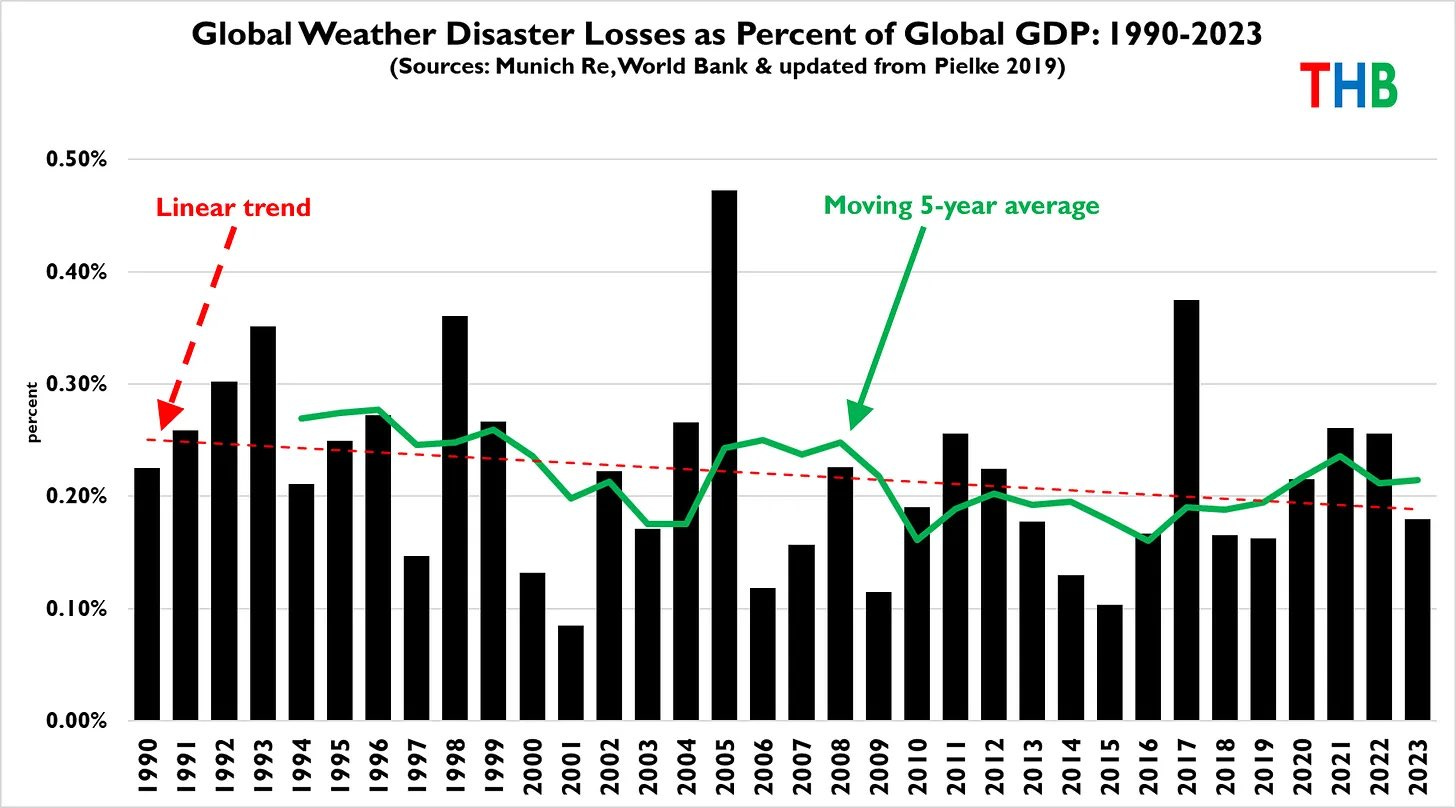
-
We often hear that “billion-dollar disasters” have increased significantly. But this is a bogus metric. Of course, as GDP grows we'll have more billion-dollar disasters because there is more wealth for disasters to strike. But when we adjust for GDP there's no increase in damage.14

-
A Reuters “fact check” alarmingly claims a 151% growth in disaster damages from a period starting in 1978 to a period ending in 2017.
But they evade that the global economy grew by over 200% during that period!
(And they evade that disaster and damage reporting increased.)15

-
The stupidest climate safety denial myth (used by The New York Times): 2 million people died from extreme weather in the last 50 years; that's obviously an emergency.
Truth: 2 million in 50 years is a rate of 40,000 per year—far, far less than 100 years ago, thus confirming today's climate safety.16
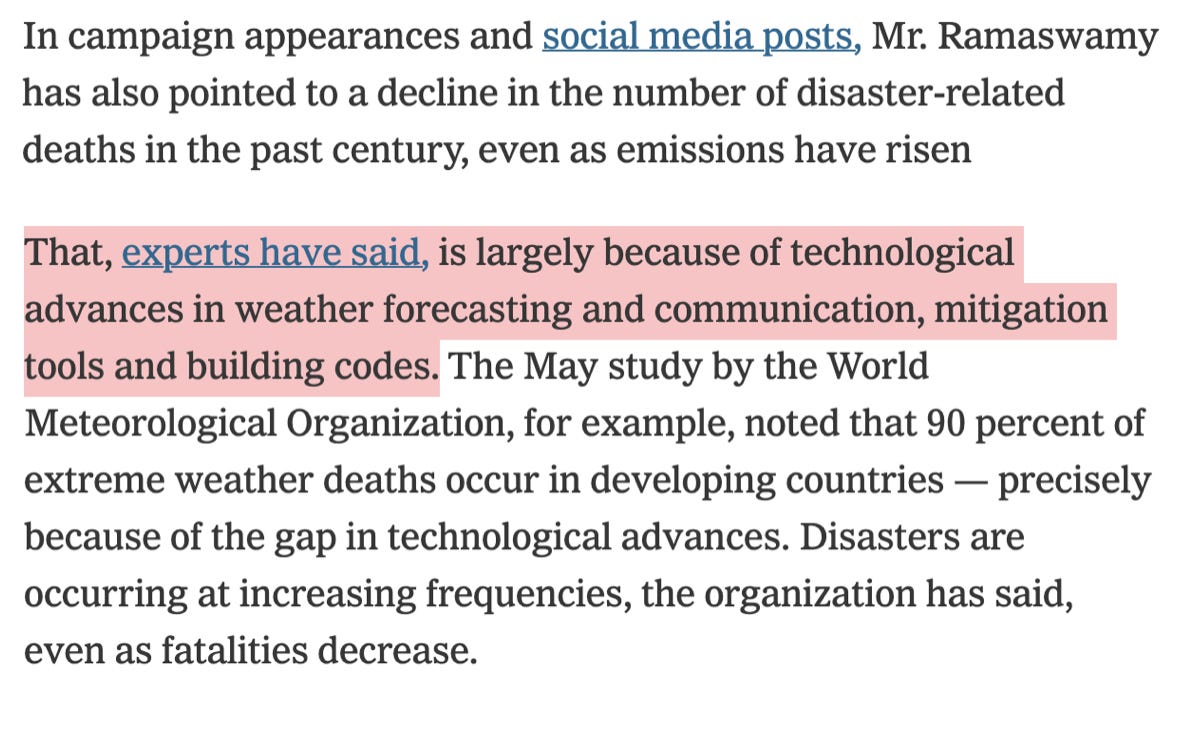
-
The last-gasp climate safety denial myth: Okay, we're safer than ever from climate disasters, and it is driven by cheap energy from fossil fuels, but we can easily replace fossil fuels with solar and wind.
Truth: For the foreseeable future there is no cheap global energy without fossil fuels.
Myth: Solar and wind are cheaper than fossil fuels -
Observe that all these seemingly scientific outlets, such as The New York Times, Reuters, and PolitiFact are totally unable to refute the death-blow to their “climate emergency” narrative that is the drastic decline in climate disaster deaths.
Science requires that they admit defeat.
References
-
Reuters - Fact Check: Drop in climate-related disaster deaths not evidence against climate ‘emergency’↩
-
NYT - Fact-Checking Vivek Ramaswamy on the Campaign Trail
USA Today - Video wrongly claims past disaster deaths show climate change isn't real | Fact check↩
-
UC San Diego - The Keeling Curve
For every million people on earth, annual deaths from climate-related causes (extreme temperature, drought, flood, storms, wildfires) declined 98%--from an average of 247 per year during the 1920s to 2.5 per year during the 2010s.
Data on disaster deaths come from EM-DAT, CRED / UCLouvain, Brussels, Belgium – www.emdat.be (D. Guha-Sapir).
Population estimates for the 1920s from the Maddison Database 2010, the Groningen Growth and Development Centre, Faculty of Economics and Business at University of Groningen. For years not shown, population is assumed to have grown at a steady rate.
Population estimates for the 2010s come from World Bank Data.↩
-
UC San Diego - The Keeling Curve
For every million people on earth, annual deaths from climate-related causes (extreme temperature, drought, flood, storms, wildfires) declined 98%--from an average of 247 per year during the 1920s to 2.5 per year during the 2010s.
Data on disaster deaths come from EM-DAT, CRED / UCLouvain, Brussels, Belgium – www.emdat.be (D. Guha-Sapir).
Population estimates for the 1920s from the Maddison Database 2010, the Groningen Growth and Development Centre, Faculty of Economics and Business at University of Groningen. For years not shown, population is assumed to have grown at a steady rate.
Population estimates for the 2010s come from World Bank Data.↩
-
Reuters - Fact Check: Drop in climate-related disaster deaths not evidence against climate ‘emergency’↩
-
UC San Diego - The Keeling Curve
For every million people on earth, annual deaths from climate-related causes (extreme temperature, drought, flood, storms, wildfires) declined 98%--from an average of 247 per year during the 1920s to 2.5 per year during the 2010s.
Data on disaster deaths come from EM-DAT, CRED / UCLouvain, Brussels, Belgium – www.emdat.be (D. Guha-Sapir).
Population estimates for the 1920s from the Maddison Database 2010, the Groningen Growth and Development Centre, Faculty of Economics and Business at University of Groningen. For years not shown, population is assumed to have grown at a steady rate.
Population estimates for the 2010s come from World Bank Data.
PolitiFact - More deaths from climate policies than climate change? Scientists say Ramaswamy’s claim is baseless↩
-
Reuters - Fact Check: Drop in climate-related disaster deaths not evidence against climate ‘emergency’↩
-
Reuters - Fact Check: Drop in climate-related disaster deaths not evidence against climate ‘emergency’↩
-
Image by Roger Pielke Jr.
-
Ryan N. Maue - Climate Atlas, Global Tropical Cyclone Activity
-
NOAA - U.S. struck with historic number of billion-dollar disasters in 2023
Roger Pielke Jr. - "Billion Dollar Disasters" are a National Embarrassment↩